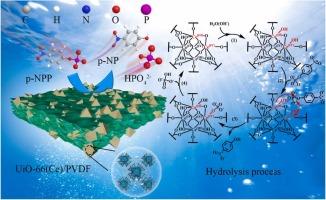UiO-66(Ce) Nanozymes with Dual-site Synergistic Catalysis for Efficient Hydrolysis of Organophosphorus Poisons
IF 11.3
1区 环境科学与生态学
Q1 ENGINEERING, ENVIRONMENTAL
引用次数: 0
Abstract
Nanozymes are a class of nanomaterials capable of mimicking the activity of phosphatase, offering sustainable hydrolysis and efficient catalytic strategies to address environmental pollution caused by organophosphorus pesticides (OPs). However, challenges such as low activity and insufficient mechanistic understanding of nanozymes remained critical concerns. Herein, UiO-66(Ce) was synthesized and loaded onto polyvinylidene difluoride (PVDF) to obtain UiO-66(Ce)/PVDF for hydrolysis of p-nitrophenol phosphate (p-NPP), a simulant of OPs. The structure of UiO-66(Ce) contained three proton types, namely μ3-OH, Ce-OH2, and Ce-OH. It was shown that the catalytic activity originated from the defect site (Ce-OH2/Ce-OH). Water molecules on the Ce-OH2 site dissociated to produce OH- during catalysis, which led to the formation of Ce-OH. The process was enhanced in alkaline environments. Interestingly, Ce-OH with different valences played distinct roles during hydrolysis of p-NPP. On this basis, OH--assisted Ce(III)/Ce(IV)-OH dual-site synergistic catalytic mechanism was proposed: the Ce(IV)-OH site first coordinated with the phosphate group to reduce its electron density and activate the P-O bond, and then the Ce(III)-OH site attacked the P atom to realize the nucleophilic attack on the P-O bond. Finally, UiO-66(Ce)/PVDF was adhered to the impeller for hydrolysis of p-NPP, providing novel insights into removing p-NPP from water bodies.

双位点协同催化UiO-66(Ce)纳米酶高效水解有机磷毒物
纳米酶是一类能够模拟磷酸酶活性的纳米材料,为解决有机磷农药造成的环境污染提供了可持续的水解和高效的催化策略。然而,诸如低活性和对纳米酶的机制了解不足等挑战仍然是关键问题。本文合成了UiO-66(Ce),并将其负载到聚偏二氟乙烯(PVDF)上,得到UiO-66(Ce)/PVDF,用于水解OPs的模拟物对硝基酚磷酸(p-NPP)。UiO-66(Ce)的结构包含μ3-OH、Ce- oh2和Ce- oh三种质子类型。结果表明,催化活性来源于缺陷位点(Ce-OH2/Ce-OH)。在催化过程中,Ce-OH2位点上的水分子解离产生OH-,从而形成Ce-OH。在碱性环境下,该过程得到了加强。有趣的是,不同价的Ce-OH在p-NPP的水解过程中发挥了不同的作用。在此基础上,提出了OH-辅助Ce(III)/Ce(IV)-OH双位点协同催化机理:Ce(IV)-OH位点首先与磷酸基配合,降低其电子密度,激活P- o键,然后Ce(III)-OH位点攻击P原子,实现对P- o键的亲核攻击。最后,UiO-66(Ce)/PVDF粘附在叶轮上水解p-NPP,为从水体中去除p-NPP提供了新的见解。
本文章由计算机程序翻译,如有差异,请以英文原文为准。
求助全文
约1分钟内获得全文
求助全文
来源期刊

Journal of Hazardous Materials
工程技术-工程:环境
CiteScore
25.40
自引率
5.90%
发文量
3059
审稿时长
58 days
期刊介绍:
The Journal of Hazardous Materials serves as a global platform for promoting cutting-edge research in the field of Environmental Science and Engineering. Our publication features a wide range of articles, including full-length research papers, review articles, and perspectives, with the aim of enhancing our understanding of the dangers and risks associated with various materials concerning public health and the environment. It is important to note that the term "environmental contaminants" refers specifically to substances that pose hazardous effects through contamination, while excluding those that do not have such impacts on the environment or human health. Moreover, we emphasize the distinction between wastes and hazardous materials in order to provide further clarity on the scope of the journal. We have a keen interest in exploring specific compounds and microbial agents that have adverse effects on the environment.
 求助内容:
求助内容: 应助结果提醒方式:
应助结果提醒方式:


